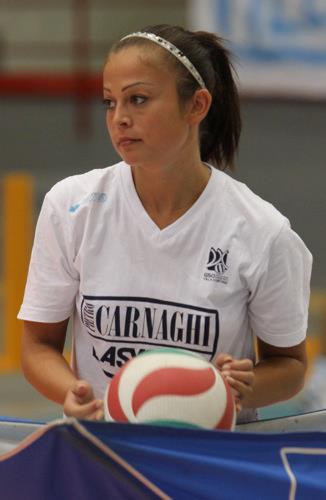Yikes!
Due to this SERIOUS injury, we won’t bee seeing Paola Cardullo for 1 year.
Sad…
We really thought she’d make a comeback this season and that she has already recovered. Paola missed the 2012 London Olympics because of this injury in her right ankle.
Over the weekend, the 162cm libero has released this statement:
“I wanted to take stock of the situation because the last tests have diagnosed a problem more serious than expected, I will have to undergo another surgery that I will postpone my situation because untreated can have serious consequences in my life private.
I’ll do a stem cell transplant and I have to stop for a year. I wanted to be the one to tell you this because we do not want to be misunderstood on this thing. My pathology is a osteonecrosis of fourth level which is the most serious and this is the only solution.
The date has not been set yet, but what is sure is that I will work at Rizzoli in Bologna with Professor Giannini. “
Paola has the support of her Italian club team, Asystel Mc Carnaghi Villa Cortese, and has been assured that she is very welcomed to play for them next season.
Get well soon Paola!
On the other hand, here’s some more information about Osteonecrosis:
Osteonecrosis is bone death caused by poor blood supply to the area. It is most common in the hip and shoulder, but can affect other large joints such as knee, elbow, wrist and ankle.
Causes, incidence, and risk factors: Osteonecrosis occurs when part of the bone does not get blood and dies. After a while the bone can collapse. If this condition is not treated, the joint will deteriorate and this will become severe arthritis. Osteonecrosis can be caused by disease, or a severe trauma, such as a break or dislocation, that affects the blood supply to the bone. Many times, no trauma or disease is present. This is called “idiopathic osteonecrosis” — meaning it occurs without any known cause.
The following can cause osteonecrosis: Long-term treatments with steroids, Excessive alcohol use, Sickle cell disease, Radiation therapy, Gaucher disease, Decompression sickness from a lot of deep sea diving, Dislocation or fractures around a joint.
Some diseases that may be associated with the development of this condition include: Gout, Atherosclerosis, Diabetes
When osteonecrosis occurs in the shoulder joint, it is usually due to long-term treatment with steroids or a history of trauma to the shoulder.
Legg-Calvé-Perthes disease is a similar condition seen in children and adolescents.
Symptoms: There are no symptoms in the early stages.
As bone damage worsens, you may have the following symptoms: Pain in the joint that may increase over time, and will become very severe if the bone collapses, Pain that occurs even at rest, Limited range of motion, Groin pain, if the hip joint is affected, Limping, if the condition occurs in or below the hips.
Signs and tests: Your health care provider will do a complete physical exam to find out if you have any diseases or conditions that may affect your bones. You will be asked questions about your symptoms and medical history.
The questions might include: When did the pain start? Does the pain spread (radiate) anywhere? Is the pain constant, or does it get better at night or at rest? Have you noticed any difference in how much or how far you can move (your mobility)? Do pain relievers help? Are you taking any steroids now, or have you ever taken them? Do you drink alcohol? If so, how much?
Be sure to let your health care provider know about any medications or vitamin supplements you are taking, even over-the-counter medicine.
After the exam, your health care provider will order one or more of the following tests: X-ray, MRI, Bone scan, CT scan, Treatment.
If your health care provider knows the reason for osteonecrosis, part of the treatment will be aimed at the underlying condition. For example, if a blood clotting disorder is the reason, treatment will consist, in part, of clot-dissolving medicine.
If the condition is caught very early, you will take pain relievers and limit use of the affected area. This may include using crutches if your hip, knee, or ankle is affected. You may need to do range-of-motion exercises. Nonsurgical treatment can often slow the progression of osteonecrosis, but most people will need surgery.
Surgical options include: A bone graft, A bone graft along with its blood supply (vascularized bone graft), Cutting the bone and changing its alignment to relieve stress on the bone or joint (osteotomy), Total joint replacement, Removing part of the inside of the bone (core decompression) to relieve pressure and allow new blood vessels to form.
(source: ncbi.nlm.nih.gov)




One Comment
Leave a Reply